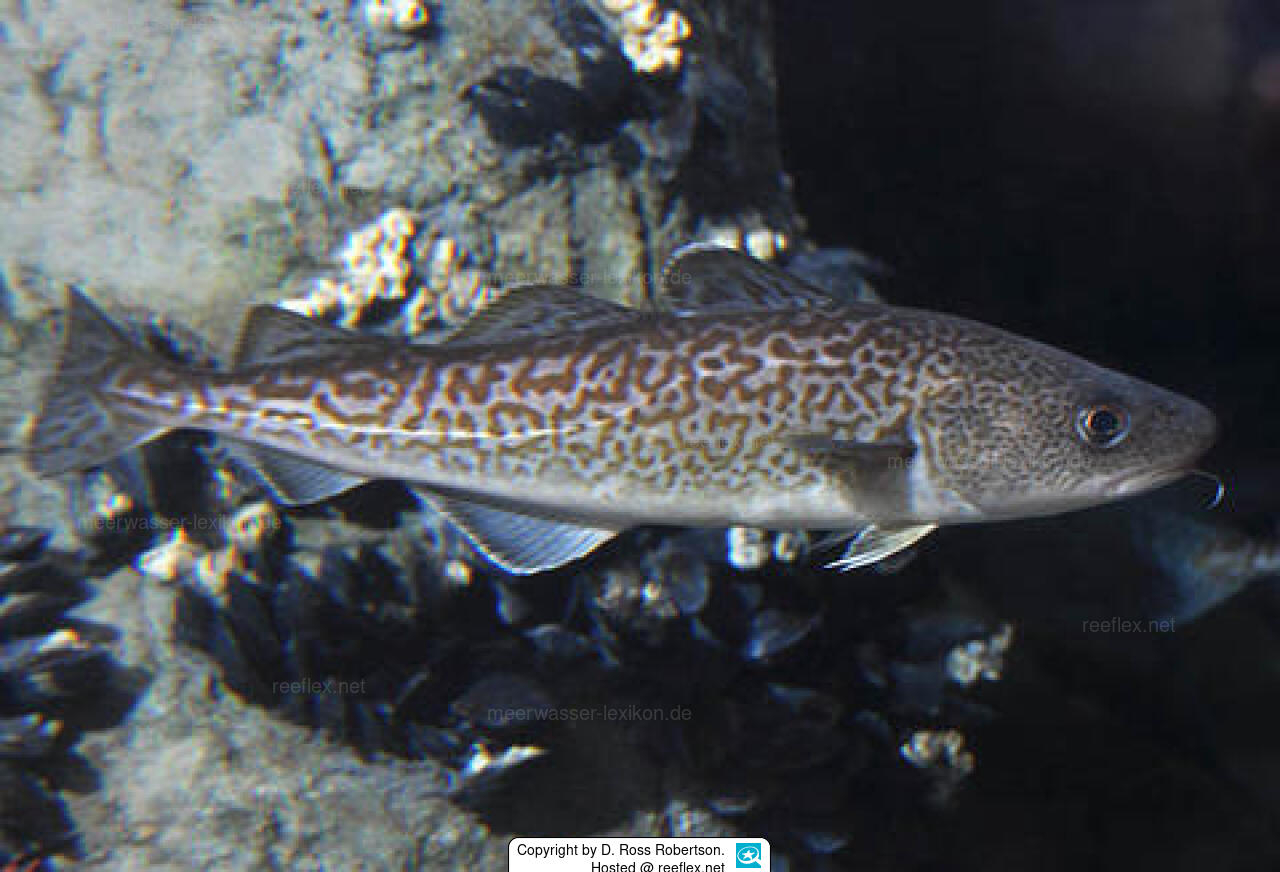Info
Gadus macrocephalus ist ein wahlloser Räuber, der alles frisst, was ihm vor das Maul kommt, Hauptsache, es passt rein.
Der Pazifischer Kabeljau bildet große Schwärme und große Wanderungen, um die Aleuten, einer Inselkette zwischen Nordamerika und Asien am Südrand des nordpazifischen Beringmeers, zu laichen.
Gadus macrocephalus wird kommerziell befischt und ist ein wertvoller Speisefisch, der u.a. auch im der Chinesischen Medizin eine wichtige Rolle spielt.
Der Pazifischer Kabeljau reagiert bereits auf die langsame aber kontinuierliche Erwärmung des Beringmeers und zieht in immer mehr nördliche, kältere Gewässer.
Juvenile Fische haben in der Tschuktschensee eine größere Überwinterungsmortalität als in borealeren Regionen (z. B. Golf von Alaska).
Parasiten des Pazifischer Kabeljau:
Zu den Parasiten dieser Art gehören der Seehundwurm (Phocanema decipiens (Krabbe, 1878) Myers, 1959) im Fleisch, der Copepode ((Linnaeus, 1767) auf den Kiemen und der Cestode (Pyramicocephalus phocarum (Fabricius, 1780) Monticelli, 1890 im Darm.
Synonyms:
Gadus auratus Cope, 1873 · unaccepted (synonym)
Gadus brandti Hilgendorf, 1876 · unaccepted (misspelling)
Gadus brandtii Hilgendorf, 1875 · unaccepted (synonym)
Gadus callarias macrocephalus Tilesius, 1810 · unaccepted
Gadus callarias marisalbi Derjugin, 1920 · unaccepted
Gadus callarias marsi-Albi Derjugin, 1920 · unaccepted (misspelling)
Gadus callarius maris-albi Derjugin, 1920 · unaccepted (misspelling)
Gadus macrocephalus ogac (Richardson, 1836) · unaccepted
Gadus morhua macrocephalus Tilesius, 1810 · unaccepted
Gadus morhua marisalbi Derjugin, 1920 · unaccepted
Gadus morhua ogac Richardson, 1836 · unaccepted
Gadus ogac Richardson, 1836 · unaccepted (synonym)
Gadus ogat Krøyer, 1847 · unaccepted (synonym)
Gadus ovak Reinhardt, 1837 · unaccepted (synonym)
Gadus pygmaeus Pallas, 1814 · unaccepted (synonym)
Der Pazifischer Kabeljau bildet große Schwärme und große Wanderungen, um die Aleuten, einer Inselkette zwischen Nordamerika und Asien am Südrand des nordpazifischen Beringmeers, zu laichen.
Gadus macrocephalus wird kommerziell befischt und ist ein wertvoller Speisefisch, der u.a. auch im der Chinesischen Medizin eine wichtige Rolle spielt.
Der Pazifischer Kabeljau reagiert bereits auf die langsame aber kontinuierliche Erwärmung des Beringmeers und zieht in immer mehr nördliche, kältere Gewässer.
Juvenile Fische haben in der Tschuktschensee eine größere Überwinterungsmortalität als in borealeren Regionen (z. B. Golf von Alaska).
Parasiten des Pazifischer Kabeljau:
Zu den Parasiten dieser Art gehören der Seehundwurm (Phocanema decipiens (Krabbe, 1878) Myers, 1959) im Fleisch, der Copepode ((Linnaeus, 1767) auf den Kiemen und der Cestode (Pyramicocephalus phocarum (Fabricius, 1780) Monticelli, 1890 im Darm.
Synonyms:
Gadus auratus Cope, 1873 · unaccepted (synonym)
Gadus brandti Hilgendorf, 1876 · unaccepted (misspelling)
Gadus brandtii Hilgendorf, 1875 · unaccepted (synonym)
Gadus callarias macrocephalus Tilesius, 1810 · unaccepted
Gadus callarias marisalbi Derjugin, 1920 · unaccepted
Gadus callarias marsi-Albi Derjugin, 1920 · unaccepted (misspelling)
Gadus callarius maris-albi Derjugin, 1920 · unaccepted (misspelling)
Gadus macrocephalus ogac (Richardson, 1836) · unaccepted
Gadus morhua macrocephalus Tilesius, 1810 · unaccepted
Gadus morhua marisalbi Derjugin, 1920 · unaccepted
Gadus morhua ogac Richardson, 1836 · unaccepted
Gadus ogac Richardson, 1836 · unaccepted (synonym)
Gadus ogat Krøyer, 1847 · unaccepted (synonym)
Gadus ovak Reinhardt, 1837 · unaccepted (synonym)
Gadus pygmaeus Pallas, 1814 · unaccepted (synonym)







 Dr. D. Ross Robertson, Panama
Dr. D. Ross Robertson, Panama


